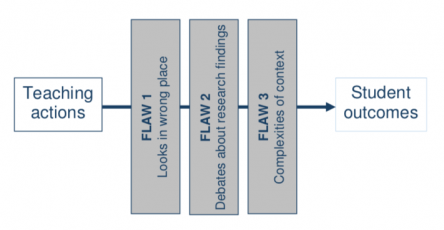The style view
“Teaching effectiveness is determined by what the teacher does.”
The following statements illustrate this view of teaching effectiveness:
- Effective teachers display warmth.
- Effective teachers are enthusiastic.
- Effective teachers provide an overview at the start of teaching something new.
- Effective teachers minimise the amount of time they are teaching the whole class from the front (direct instruction).
- Effective teachers facilitate the joint construction of knowledge through teacher-student and student-student conversations.
- Effective teachers use teaching techniques and approaches that research has shown to be effective.
These statements have an obvious appeal to teachers.
- Experience develops expertise, and experienced teachers can draw on this experience to describe the qualities of effective teaching. They can generate lists of the qualities of effective teachers and distinguish effective and ineffective teachers in the basis of these qualities.
- These lists have the appearance of being inclusive. Lists of effective teaching qualities are often long and incorporate qualities related to personal attributes (statements 1 and 2 above); teaching techniques (statement 3 above); and general teaching approaches (statements 4 and 5 above).
- Research can often be cited to support these qualities giving them credibility and strength.
While none of the statements above are themselves unimportant, the assessment of teaching effectiveness against such qualities is flawed for at least three reasons. These are illustrated in figure 1 and explained in the following text.
Figure 1: Style-based teaching effectiveness
The solid arrow in figure 1 represents the thinking behind the style-based conception of teaching effectiveness, that is, particular teaching actions generate desired student outcomes.
The three vertical boxes summarise the main flaws in this conception.
Flaw 1
The approach looks in the wrong place. It focuses on what the teacher demonstrates (against a predetermined list of qualities deemed to be effective) rather than what is happening for the students. As David Berliner (1987) explains, the fundamental flaw of this approach is that a teacher can be judged to be good if they model the desired practices irrespective of whether the students learn [italics added] (p. 266). It is not unlike assessing a golfer or a tennis player on the quality of their swing or action rather than where the ball goes.
Flaw 2
It assumes that the research generalisations are unequivocal. The ongoing and sharply polarised debate around teacher use of rewards is one of the many examples in teaching of disputed findings which challenge the assumption that there are clear research generalisations available about the impact of particular styles.
Flaw 3
The arrow assumes a linear connection that is complicated by such contextual factors as:
- the nature of the students
- the subject being taught
- the time of day
- the nature of the teaching environment
- the availability of resources.
The complex contexts of teaching are such that it is simplistic to claim that there is one right way to teach – for example, cooperative learning, or facilitation, or direct instruction – or that there are a list of qualities that can define a right way of teaching.
Research generalisations, as generalisations, are not necessarily valid for all students in all contexts. That is why it was claimed above that lists of style-based teaching criteria only appear to be inclusive.
They are often inclusive of a general idealised view of teaching, not for the particular daily circumstances of teaching.
The key question as Ackerman (2003) explains is not the approach the teacher is using but the value of that approach in the particular context within which they are teaching: there is nothing intrinsically bad about (direct instruction) or good about (co-operative learning). The overriding question must always be: In the time available, which pedagogical pathway is likely to lead students to the biggest pot of educational gold? (p. 345)
In summary, it is not what the teacher does that matters, it is what is happening for the students. This brings us to the second approach to conceptualising teaching effectiveness.
[link to Outcomes approach]
References
Ackerman, D. (2003). Taproots for a new century: Tapping the best of traditional and progressive education. Phi Delta Kappan, 84 (3), p344–349.
Berliner, D. (1987). Simple views of effective teaching and a simple theory of classroom instruction. In D. Berliner, B. Rosenshine (Eds.), Talks to teachers. New York: Random House.

